Sharply Divided Supreme Court Hears Argument In Challenge To Obama’s Deportation Relief Plan
The Supreme Court heard oral argument in the case challenging the President's deportation relief plan, but it's unlikely we'll see a ruling on the merits.
A sharply divided, and seemingly equally balanced, Supreme Court heard argument today in the challenge filed by Texas and several other states to the temporary immigration relief program announced by President Obama in November 2014:
WASHINGTON — The Supreme Court on Monday seemed sharply divided during an extended argument over a challenge to President Obama’s plan that would shield millions of undocumented immigrants from deportation and allow them to work in the country legally.
Much of the argument was technical, but the justices occasionally paused to acknowledge realities outside the courtroom. Justice Stephen G. Breyer said the case had enormous political implications. Justice Sonia Sotomayor said that about 11 million immigrants live “in the shadows.”
“They’re here whether we want them or not,” Justice Sotomayor said.
The case, brought by 26 states, may produce a significant ruling on presidential power and immigration policy in the midst of a presidential campaign in which both issues have been prominent.
Solicitor General Donald B. Verrilli Jr., the government’s top appellate lawyer, opened the arguments with a vigorous defense of Mr. Obama’s authority to set priorities for immigration enforcement, but within minutes he was challenged by Chief Justice John G. Roberts Jr. and several of the court’s other members.
Justice Anthony M. Kennedy questioned whether the president can defer deportations for millions of people without specific congressional authorization, saying “that is a legislative task, not an executive task.”
“It’s as if the president is defining the policy and the Congress is executing it,” Justice Kennedy said. “That’s just upside down.”
In making his case, Mr. Verrilli asserted that the state of Texas should not be allowed to challenge the president’s actions by claiming that it would cost the state money to give driver’s licenses to the millions of immigrants affected by the federal policy. Mr. Verrilli argued that Texas could simply change its law to deny driver’s licenses to the immigrants.
“You would sue them instantly,” Chief Justice Roberts said as he repeatedly questioned the government’s arguments.
He also pressed Mr. Verrilli on whether the president could simply deem all illegal immigrants to be legally present under the new policy. Mr. Verrilli said there were statutory constraints that would prevent the president from doing so.
Scott A. Keller, Texas’s solicitor general, said Mr. Obama’s plan was unprecedented and unlawful. He faced skeptical questions from the court’s more liberal members about whether his state had suffered the sort of direct and concrete injury that gave it standing to sue.
The case, United States v. Texas, No. 15-674, was heard by an eight-member court, and the absence of Justice Antonin Scalia, who died in February, has altered the judicial dynamic. A 4-4 deadlock is now a live possibility, one that would leave in place an appeals court ruling that blocks the plan without setting a Supreme Court precedent.
(…)
The states challenging Mr. Obama’s immigration plan say he has repeatedly taken unilateral and unlawful action to sidestep Congress on gun control, gay rights, the minimum wage, contraception and climate change. White House and Justice Department officials have defended Mr. Obama’s approach as legal and valuable.
Monday’s case concerns a program intended to allow as many as five million unauthorized immigrants who are the parents of citizens or of lawful permanent residents to apply for a program sparing them from deportation and providing them work permits. The program, announced in November 2014, was called Deferred Action for Parents of Americans and Lawful Permanent Residents, or DAPA.
In February 2015, Judge Andrew S. Hanen of Federal District Court in Brownsville, Tex., entered a preliminary injunction shutting down the program while the legal case proceeded. The government appealed, and a divided three-judge panel of the United States Court of Appeals for the Fifth Circuit, in New Orleans, affirmed the injunction.
If the Supreme Court upholds Mr. Obama’s actions, the White House has vowed to move quickly to set up the program and begin enrolling immigrants before his successor takes over early next year. Democratic presidential candidates have said they would continue the program, but most of the Republicans in the race have vowed to dismantle it and redouble immigration enforcement.
In their Supreme Court briefs, the states acknowledged that the president has wide authority over immigration matters, telling the justices that “the executive does have enforcement discretion to forbear from removing aliens on an individual basis.” Their quarrel, they said, was with what they called a blanket grant of “lawful presence” to millions of immigrants, entitling them to various benefits.
In response, Mr. Verrilli told the justices that “lawful presence” is merely what has always followed from the executive branch’s decision not to deport someone for a given period of time.
“Deferred action does not provide these individuals with any lawful status under the immigration laws,” he said. “But it provides some measure of dignity and decent treatment.”
“It recognizes,” Mr. Verrilli added, “the damage that would be wreaked by tearing apart families, and it allows individuals to leave the shadow economy and work on the books to provide for their families, thereby reducing exploitation and distortion in our labor markets.”
If the states are to prevail, they must show that they have suffered the sort of direct and concrete injury that gives them standing to sue.
Lyle Denniston has more:
No matter which way the Supreme Court turns on President Barack Obama’s ambitious move to overhaul immigration policy, it can get to a result only if a fifth vote can be found to make a majority among the eight Justices. That, at least, seemed likely after a ninety-minute argument on Monday inUnited States v. Texas, the fiercely contested courthouse battle between the White House and Congress over who among eleven-or-so million immigrants can stay in the country without a specific legal right to do so.
The Court’s four liberal members were working extra hard to make the central issue whether state governments can even be in court to challenge how the government enforces immigration laws — a thrust that encountered some significant resistance from a few others on the bench. It may have been that the strength of their efforts arose out of a fear that they could not win on the legality of the policy itself, but a realization that the conservatives also are not likely to hold the votes needed to prevail on the merits.
At repeated points during the argument, it appeared that the Obama administration might actually be able to salvage its policy as both legal and enforceable (if the lawsuit were allowed to go forward) by simply deleting from the regulations in dispute a two-word phrase: “lawful presence.” It was very clear during the challengers’ argument — by lawyers for the twenty-six states and for the U.S. House of Representatives — that the phrase carries enormous meaning for them, that they see it as the equivalent of a whole new immigration law enacted by the White House, not Congress.
At one point, Justice Anthony M. Kennedy, who could wind up holding a decisive vote, appeared to hint that he agreed that this is what happened, that in this instance, the normal order of government policymaking had been turned “upside down,” as he put it.
The Obama administration’s lawyer sought to defuse that complaint by telling the Court, in response to several questions about the phrase, that it stands for nothing whatsoever, and could simply be deleted without affecting the policy in any way. But, if that is the solution, would it be enough to generate five votes in favor of the policy? It was hard to envision that on Monday, making more sense of the heavy focus on the states’ right to sue in the first place. If the states were constitutionally barred from suing, the case would be over — period.
A federal judge in Texas and the U.S. Court of Appeals for the Fifth Circuit allowed the states’ challenge to go forward on the theory that at least one of the states — Texas — would suffer a significant budget impact if it were faced with handing out drivers’ licenses to perhaps millions of undocumented immigrants, if they gained the right to stay in the United States. That impact, the lower courts said, was what gave Texas the right to sue on behalf of itself and twenty-five sister states.
At Monday’s arguments, a series of rapid-fire questions by Justices Stephen G. Breyer, Ruth Bader Ginsburg, Elena Kagan, and Sonia Sotomayor highlighted the potentially decisive significance of the constitutional question about when state governments may sue the federal government because of a disagreement over federal policy. That is a question under the Constitution’s Article III, which limits federal courts’ authority to deciding live legal controversies, those in which someone can claim to have been specifically harmed by government action.
Breyer trotted out prior Supreme Court precedents on Article III “standing” to make the point, and his three liberal colleagues had an array of objections to the states’ right to sue to block the Obama policy announced seventeen months ago, but not yet in effect because of lower court temporary orders against enforcement.
Chief Justice John G. Roberts, Jr., and Justice Samuel A. Alito, Jr., were aggressive questioners of the administration lawyer, Solicitor General Donald B. Verrilli, Jr., on the “standing” question. Both seemed to have come into the argument inclined to accept that Texas and the other states did have enough at stake that they should have the right to take their grievance to court. But there did not appear to be support for that from any of their colleagues; Kennedy was not noticeably favorable to the states on that point; Justice Clarence Thomas said nothing during the argument.
(…)
The Chief Justice and Justice Alito used up much of the ten minutes allowed for a lawyer representing undocumented parents who could benefit from the Obama policy, with most of their questions on the “standing” issue. Thomas A. Saenz of the Mexican American Legal Defense and Educational Fund had little opportunity to talk about the merits of the policy.
Scott A. Keller, the Texas state solicitor general arguing here for all of the twenty-six states, had much of his time at the lectern absorbed in exchanges with the Justices pressing their point against the right to sue, and those exchanges were seldom interrupted by any of the other Justices. The Chief Justice, in particular, avoiding questioning Keller about the “standing” issue.
When the Court first accepted the Federal Government’s appeal of the rulings of the Fifth Circuit and District Court, it appeared as though we might be headed for a Constitutionally significant ruling not just on the issue of immigration reform but also on the relationship between the Executive and Legislative Branches. This was due to the fact that, in addition to the questions that the Federal Government asked the Court to consider in its review of the case, the Court ordered the parties to address the question of whether or not the Administration’s plan violated the Constitutional requirement that the President “take care that the laws be faithfully executed.” At the time, many Court observers took the addition of this question as a sign that the Court’s conservatives believed that they had the upper hand in the case and that this case could end up serving as a seminal and potentially historic ruling on the balancing of powers between the branches of the Federal Government, including the argument that many have made in recent decades that this balance had become strongly biased in favor of an increasingly “imperial” Presidency. Since then, of course, the Supreme Court has undergone a significant change due to the death of Justice Antonin Scalia and is likely to change even further whenever it may be the Justice Scalia’s replacement is finally confirmed, an event that may not take place until early 2017 due to the Senate’s continued refusal to consider any nomination until after the Presidential election.
Now,with the Court seemingly evenly divided ideologically the odds of seeing such a broad ruling from the Court are essentially zero. Instead, there are only a limited number of possible outcomes in the case. The first and seemingly most likely outcome is that the Court divides 4- 4 on the merits of the case, which means that the stay on the DAPA policy put in effect by the District Court and affirmed by the Fifth Circuit would remain in effect and that the case would proceed to a hearing on the merits in the District Court only to make its way back through the appeals process to the Supreme Court, a process that could take a year or more. A second possibility is that one of the Justices in either the conservative or liberal camp will break with their brethran and join four other Justices in some kind of ruling on the merits either in favor of the Administration’s policy or holding that it violated the Constitution and applicable law. In this case, it would seem more likely that Justice Kennedy would side with the liberal wing of the Court to uphold the Administration’s policy, but even that seems remote. Finally, as hinted at in the summaries quoted above, the Court could rule that the states lack standing to sue the Federal Government at all in a case such as this, and outcome which would nullify all of the Court proceedings below, lift the stay, and allow the implementation of DAPA to proceed forward at least for the remainder of the time that President Obama remains in office. This certainly seems to be the direction that the Court’s four liberal members think the case should take, the question is whether they’d be able to convince any of their fellow Justices to go along with this down this road. The most likely members of the conservative wing of the Court to by sympathetic to this type of argument are Justice Kennedy and Chief Justice Roberts, both of whom have been highly skeptical of the expansion of Article III standing in the past.
As always, it’s always a risk to try to predict from oral argument which way a case may turn out, but it strikes me from reading the reports of the argument and an initial quick read of the argument transcript that the most likely outcome is either a 4-4 stalemate or a ruling that the states lack standing in which either Kennedy or Roberts, or both, join the Court’s liberals in a ruling that the states lack standing to sue in this case. If ends up being a stalemate, then we’re likely to find that out fairly soon since the Court will know at least the initial vote on the case after its conference on Friday morning. If it’s any of the other possibilities, then this is likely to be one of those cases we’re waiting for at the end of June.
Here’s the transcript:
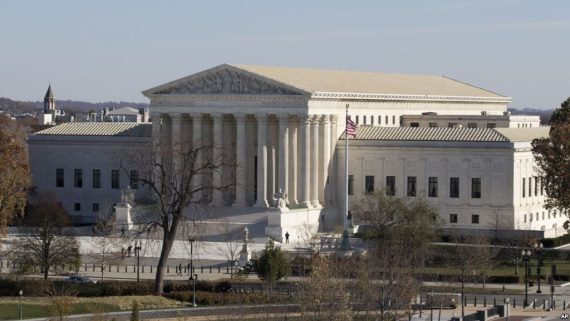

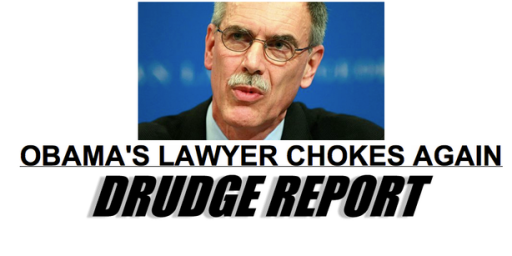
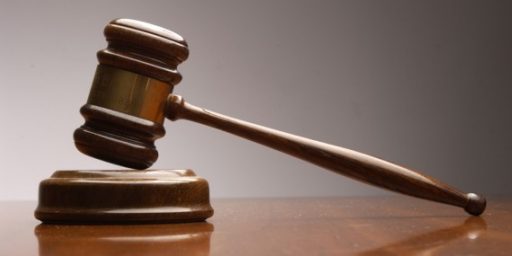
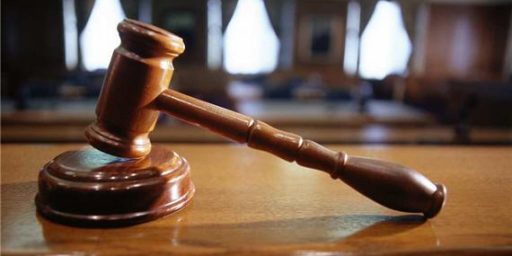
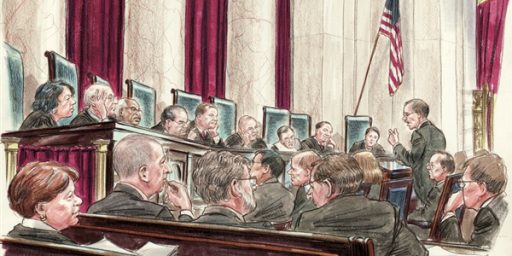
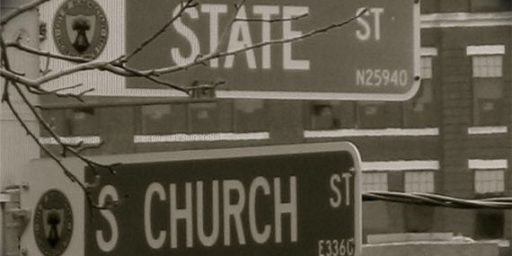
I wonder how a Justice Garland would align on this issue?
@al-Ameda: i’m thinking to the left! either way, the prez should not be rewarding those who cut in line. we can’t solve mexico’s problems by taking in their cast-offs, sooner or later they’re going to have to figure out how to run a country in a “somewhat successful” manner.
I could get used to this eight-member Supreme Court thing.
@al-Ameda:
Surely Garland would be exactly the same as replacing Marshall with Thomas.
After all, no one should shake up the ideological vision of the court just because a seat is open.
At least that’s what any good graduate of ASSOL would tell you. And they would know.
@bill: “we can’t solve mexico’s problems by taking in their cast-offs, sooner or later they’re going to have to figure out how to run a country in a “somewhat successful” manner.”
Who said anything about trying to solve Mexico’s problems?
@Davebo:
Actually, I was asking a serious question.
I suspect that on this issue Merrick Garland would find that the president is exercising his constitutional powers correctly.
@al-Ameda:
I suspect the four conservative Justices are looking for a compromise here because they suspect that the government will win a total victory once a Democratic President seats their appointee if the case is re-argued next year. IMO, you are right, Garland would find for the Government-and he would be conservatives’ best hope.
@al-Ameda:
SCOTUSBlog’s Garland write-up painted him as favoring deference to agency decisionmakers (with a possible exception when it comes to environmental challenges from the Left):
The most delicious outcome would be for Hillary to nominate Obama for the empty seat on the court and for his vote to be the fifth one upholding his previous action as president…granted, that would be an enormous conflict of interest, but such conflicts in the past haven’t caused conservatives on the court to recuse themselves…